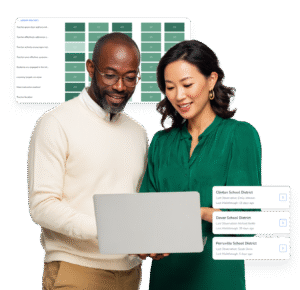In today’s world, education is increasingly reliant on technology. The digital revolution has transformed classrooms, opening up new opportunities for both students and teachers. However, implementing and maintaining digital tools can be costly, which is where Title 1 and ESSER (Elementary and Secondary School Emergency Relief) funds come into play. These funds allow schools to invest in technology and enhance the learning experience. In this article, we will explore how schools can creatively utilize Title 1 and ESSER funds for digital classroom walkthrough tools, and maximize their impact on education.
Understanding Title 1 and ESSER Funds
The Basics of Title 1 and ESSER Funds
Before diving into the creative ways these funds can be used, it’s essential to understand their foundation. Title 1 funds are federal funds allocated to schools with a high percentage of students from low-income families. These funds are intended to bridge the achievement gap and improve academic outcomes for these students.
These funds have a long history, dating back to the Elementary and Secondary Education Act of 1965. The legislation aimed to provide equal educational opportunities for all students, regardless of their socioeconomic background. Title 1 funds play a crucial role in ensuring that students from low-income families have access to quality education and the necessary resources to succeed.
On the other hand, ESSER funds were established in response to the COVID-19 pandemic, providing emergency funding to schools to address the impact of the pandemic on education. These funds allow schools to invest in various areas, including technology, to support remote and in-person learning.
The Coronavirus Aid, Relief, and Economic Security (CARES) Act, passed by Congress in March 2020, allocated $13.2 billion in ESSER funds to K-12 schools across the United States. These funds have been instrumental in helping schools navigate the challenges posed by the pandemic, such as implementing distance learning programs, ensuring student and staff safety, and addressing learning loss.
How Schools Can Access These Funds
Both Title 1 and ESSER funds are distributed to schools through the U.S. Department of Education. Schools need to develop and submit a comprehensive plan highlighting how they intend to use the funds to improve educational outcomes. It’s important for schools to prioritize technology integration as part of their plan, as digital tools can significantly enhance the learning process.
When applying for Title 1 funds, schools must demonstrate that they meet the eligibility criteria, which includes having a certain percentage of students from low-income families. The U.S. Department of Education uses a formula to determine the amount of funding each eligible school receives.
On the other hand, ESSER funds are allocated to states based on the Title 1 formula. Each state then distributes the funds to school districts, taking into account factors such as student enrollment and poverty rates. School districts are responsible for developing their own plans for utilizing the funds and must submit them to the state education agency for approval.
It’s worth noting that schools have a significant degree of flexibility in how they can use these funds. While there are guidelines and restrictions in place to ensure the funds are used for their intended purposes, schools have the freedom to tailor their plans to meet the unique needs of their students and communities.
Some schools may choose to invest in technology infrastructure, such as upgrading their internet connectivity or purchasing devices for students. Others may focus on professional development for teachers to enhance their digital literacy skills and effectively integrate technology into their instruction. Additionally, schools can use the funds to provide targeted interventions and support services for students who have been disproportionately affected by the pandemic.
Overall, Title 1 and ESSER funds provide schools with valuable resources to address educational inequities and mitigate the impact of the COVID-19 pandemic. By strategically allocating these funds and prioritizing technology integration, schools can create more equitable learning environments and empower students to succeed academically.
The Importance of Digital Classroom Walkthrough Tools
Enhancing Education with Digital Tools
Digital classroom walkthrough tools offer a wide range of benefits for both educators and students. These tools allow teachers to seamlessly monitor student progress, provide real-time feedback, and personalize the learning experience. With digital classroom walkthrough tools, teachers can easily track student performance and identify areas where additional support may be needed. This enables them to tailor their instruction to meet the individual needs of each student, ensuring that no one is left behind.
Furthermore, these tools facilitate communication between teachers and students. Through the use of digital platforms, teachers can provide timely and specific feedback to students, highlighting their strengths and areas for improvement. This immediate feedback not only helps students understand their progress but also motivates them to strive for continuous growth and improvement.
Moreover, digital classroom walkthrough tools promote active learning and engagement. Students can actively participate in interactive, immersive activities that foster creativity and critical thinking. These tools provide opportunities for students to collaborate with their peers, solve problems, and explore new ideas. By engaging in hands-on activities, students are able to apply their knowledge and develop a deeper understanding of the subject matter.
The Role of Technology in Modern Classrooms
Technology has become an integral part of modern classrooms, transforming the way knowledge is imparted and assimilated. It fosters collaboration, enhances accessibility, and prepares students for the digital age. With the rapid advancement of technology, it is crucial for educators to embrace digital tools and incorporate them into their teaching practices.
One of the key benefits of technology in the classroom is its ability to foster collaboration among students. Through digital platforms, students can work together on projects, share ideas, and provide feedback to one another. This collaborative learning environment not only enhances students’ social and communication skills, but also encourages them to take ownership of their learning.
Additionally, technology enhances accessibility in the classroom. With digital tools, students can access learning materials anytime, anywhere. This eliminates the barriers of time and location, allowing students to learn at their own pace and in their preferred environment. Furthermore, digital tools can provide accommodations for students with special needs, ensuring that every student has equal access to education.
Furthermore, technology prepares students for the digital age and equips them with essential skills for the future. In today’s digital world, proficiency in technology is crucial for success in various careers. By integrating digital tools into the classroom, educators can help students develop digital literacy skills, such as information literacy, media literacy, and digital citizenship. These skills are essential for students to navigate and thrive in the digital landscape.
In conclusion, digital classroom walkthrough tools play a vital role in enhancing education. They empower teachers to monitor student progress, provide personalized feedback, and foster active learning. Moreover, technology in the classroom promotes collaboration, enhances accessibility, and prepares students for the digital age. As technology continues to advance, it is imperative for educators to embrace digital tools and leverage their benefits to create engaging and effective learning experiences for all students.
Creative Ways to Utilize Funding for Digital Tools
Strategic Planning for Fund Allocation
Schools should strategically plan their allocation to make the most of Title 1 and ESSER funds. It’s essential to identify the specific needs of students and teachers, and align the funding accordingly. This could include investing in interactive whiteboards, tablets, educational software, or online learning platforms. Schools should also consider providing training and professional development opportunities to ensure educators are well-equipped to utilize these tools effectively.
Innovative Approaches to Funding Technology
Some schools are taking innovative approaches to funding technology beyond traditional allocations. They are exploring public-private partnerships, crowdfunding initiatives, and grants to acquire additional resources. By thinking outside the box and seeking alternative funding options, schools can expand their digital tool arsenal, enhancing the educational experience for students and teachers alike.
Implementing Digital Classroom Walkthrough Tools
Steps to Integrate Digital Tools in the Classroom
Implementing digital classroom walkthrough tools requires careful planning and execution. It’s crucial to involve teachers in the decision-making process and provide them with the necessary training and support. Schools should establish a clear implementation plan, set goals, and regularly assess progress. As with any innovation, there may be challenges along the way. However, by fostering a growth mindset and embracing the transformative potential of technology, educators can overcome obstacles and create a dynamic learning environment.
Overcoming Challenges in Implementation
It’s important to acknowledge that the integration of technology in the classroom may not always be seamless. Schools may face challenges such as limited infrastructure, connectivity issues, or resistance to change. However, schools can overcome these obstacles by ensuring robust IT support, engaging in ongoing professional development, and nurturing a culture of collaboration and experimentation. By addressing these challenges head-on, schools can pave the way for successfully implementing and utilizing digital tools.
Measuring the Impact of Digital Classroom Walkthrough Tools
Evaluating the Effectiveness of Digital Tools
Measuring the impact of digital classroom walkthrough tools is essential to ensure their efficacy. Schools should establish clear evaluation criteria and collect data on student engagement, academic performance, and teacher feedback. Additionally, regular communication with teachers and students is crucial to identify areas for improvement and make necessary adjustments. By continuously monitoring and assessing the impact of digital tools, schools can refine their strategies and maximize the benefits for all stakeholders.
Long-Term Benefits of Technology in Education
Technology offers long-term benefits for education beyond immediate improvements in teaching and learning. Digital tools prepare students for future careers that require technological literacy and adaptability. They cultivate essential skills such as problem-solving, collaboration, and digital citizenship. Furthermore, technology opens up a world of opportunities for personalized and self-paced learning, catering to the unique needs and interests of individual students.
In conclusion, creatively leveraging Title 1 and ESSER funds for digital classroom walkthrough tools can revolutionize education. Schools can create innovative learning environments by understanding the basics of these funds, recognizing the importance of digital tools, and strategically utilizing funding. Implementing digital tools may come with challenges, but by measuring their impact and embracing technology’s long-term benefits, schools can empower students and equip them with the skills they need to navigate the future confidently.



